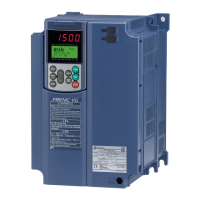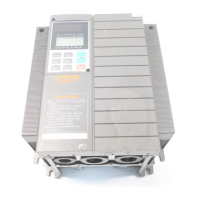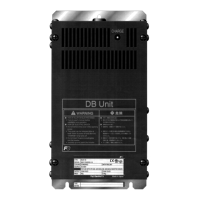Instantaneous overcurrent
Phenomena The inverter momentary output current exceeded the overcurrent level.
0c1
Overcurrent occurred during acceleration.
0c2
Overcurrent occurred during deceleration.
0c3
Overcurrent occurred during running at constant speed.
Possible Causes Check and Measures
(1) The inverter output lines were
short-circuited.
Disconnect the wiring from the inverter output terminals (U, V and W)
and measure the interphase resistance of the motor wiring. Check if the
resistance is too low.
Remove the short-circuited part (including replacement of the wires, relay
terminals and motor).
(2) Ground faults have occurred at
the inverter output lines.
Disconnect the wiring from the output terminals (U, V, and W) and
perform a Megger test.
Remove the grounded parts (including replacement of the wires, relay
terminals and motor).
(3) Overload. Measure the motor current with a measuring device to trace the current
trend. Then, use this data to judge if the trend is over the calculated load
value for your system design.
If the load is too heavy, reduce it or increase the inverter capacity.
Trace the current trend and check if there are any sudden changes in
the current.
If there are any sudden changes, make the load fluctuation smaller or
increase the inverter capacity.
Enable instantaneous overcurrent limiting (H12 = 1).
(4) Excessive torque boost
specified. The manual torque
boost is set if F37* = 0, 1, 3, or
4.
Check whether decreasing the torque boost (F09*) decreases the output
current but does not stall the motor.
If no stall occurs, decrease the torque boost (F09*).
(5) The specified acceleration/
deceleration time was too short.
Check that the motor generates enough torque required during
acceleration/deceleration. That torque is calculated from the moment of
inertia of the load and the acceleration/deceleration times.
Increase the acceleration/deceleration times (F07, F08, E10 through
E15, and H56).
Enable the current limiter (F43) and torque limiter (F40, F41, E16, and
E17).
Increase the inverter capacity.
(6) Malfunction caused by noise. Check if appropriate noise control measures have been implemented
(e.g., correct grounding and routing of control and main circuit wires).
Implement noise control measures. For details, refer to Appendix A.
Enable the retry function (H04).
Connect a surge absorber to magnetic contactor's coils or other
solenoids (if any) causing noise.
(7) Motor is idling at start-up. When the motor is idling at high speed, an excessive current flow during
start-up.
Enable auto search (H09/d67).
(8) The [PLC] and [CM] terminals
have been shorted.
Check whether the [PLC] and [CM] terminals have been shorted.
(FRN0020E2■-2/ FRN0011E2■-7/ FRN0072E2■-4 or below)

